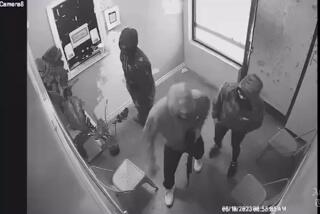Prison Bars Keep Contest Winner Out of USC Film Program : Videos: An anti-drug message prepared by California Youth Authority inmates took top prize. But the video’s teen-age writer can’t attend a summer workshop because she’s serving time for car theft.
The prizewinning video’s message is blunt: Drugs kill.
The prize is impressive: a five-week scholarship at USC’s film school.
And the winner is miffed: A California Youth Authority inmate, she cannot go to USC because she is serving time for grand theft auto.
“Flatlines,” the anti-drug video written by 16-year-old Wendy Creiglow at the CYA’s Ventura School, beat nearly 100 other student videos in May to become a finalist in the Teens Making a Difference contest held by KCET-TV Channel 28 in Los Angeles.
Two weeks ago, it wowed the USC faculty judges, who chose it as their favorite for the grand prize.
But there is no way Wendy can leave, CYA officials said, because she must remain imprisoned at least until March.
And USC officials said they finally decided to award the scholarship to Orange County student Josh Goldstein, who helped produce the second-best video, an AIDS awareness clip.
In fact, none of the Ventura School inmates who also worked on the winning video--young women serving time for car theft, armed robbery and drug crimes--will even be allowed to attend the June 30 awards ceremony at Dodger Stadium.
And when Wendy is allowed to travel to KCET’s studios today for a televised panel discussion with the hosts of KCET’s “Life and Times,” school officials said, she will be flanked by two CYA guards.
KCET is pleading with the USC faculty to award Wendy the $4,500 scholarship after her release.
But USC officials said they do not know if they can wait that long to put the San Diego County teen-ager through the intensive filmmaking class at the university’s School of Cinema Television.
“We haven’t been able to discuss it with all the people who are involved,” said Duke Underwood, who runs the summer production workshop for teen-age filmmakers.
If there is any way she can go to USC, Wendy said, “I’d love it.
“For one thing, it’s something for me to do with my life,” she said. “I love learning about new things.”
But Wendy has not met enough requirements to satisfy the parole board, Ventura School Supt. Vivian Crawford said. Even if she had, pre-parole planning takes 60 to 90 days.
“We are excited about this,” Crawford said. “But I have heard nothing from anyone who’s been involved with her that says she’s ready for that.”
Wendy, who says she is a recovering alcoholic and drug abuser, took the idea for “Flatlines” from an anti-drug poster she once drew for another class. The poster equated lines of cocaine with the flat-line readout on a machine monitoring an overdose victim’s pulse.
Just 60 seconds long, the video expands on the idea and packs a graphic punch.
While a voice-over warns that one line leads to another, images flash in quick succession: a young woman snorting a line of cocaine, the red lines of an F on a report card, the profile of a pistol, the chalk outlines of a body at a murder scene, and the flat line of a dead person’s absent pulse.
“Drugs kill,” the narrator intones, and then comes the kicker: garish yellow words reading, “A Message From Wards of the California Youth Authority.”
USC teacher Pablo Frasconi said he and the other two faculty judges thought the video was extraordinary.
“I thought it was quite above the others in the program,” said Frasconi, adding that the judges had no idea “Flatlines” was made by juvenile inmates.
“The director . . . had a very strong vision of how to tie the work together, and also it was very strong in the area of visual language,” he said. “It’s too bad that she can’t attend the workshop because it’s clear that there’s a lot of talent there that can be tapped, and I guess could help them get out of that cycle” of crime.
The young Ventura School video makers--about 15 worked on the clip--said they just hope it reaches the right people.
“I don’t like watching it, ‘cause it’s me” said Tami Jefferson, 20, of Watts, who pretends to snort a line of baking soda, plays dead and provides the voice over. “But I think it’ll turn a lot of heads and get a lot of attention.
“The commercials I’ve seen on drugs and violence didn’t get my attention, because if they did I wouldn’t be here,” said Jefferson, who is serving time for armed robbery and admits she has had problems with drugs. “I just want my 5-year-old son to see it. . . . I don’t want him to be like I am.”
Lori Taylor, a 17-year-old serving time for a strong-arm robbery, produced the soundtrack, wringing electronic gunshots and queasy, threatening chords out of a synthesizer.
She also was the only inmate willing to lie on the floor so classmates could draw the body outlines of the staged murder scene.
That scene should grab young viewers “because it’s scary,” said Mapuana Pulotu, 20. While serving time for a Riverside robbery, she says, she managed the technical side of Wendy’s video and three others submitted by inmates in the CYA video class.
“I worked hard on everything, but this was the best one,” Pulotu said.
Brad Gardner, who runs the class, says he too hopes that teen-agers who might ignore typical anti-drug messages will heed one from young women who have been there.
“We have the kids with experience in all those areas, especially drugs and violence, so they know it better than anyone,” he said.
As for Wendy’s Creiglow’s iffy prize, Gardner said, he can only wait and see, and be glad that an entry from his class won. “It’s the best thing that’s happened to my students since I’ve been here,” he said.
More to Read
Only good movies
Get the Indie Focus newsletter, Mark Olsen's weekly guide to the world of cinema.
You may occasionally receive promotional content from the Los Angeles Times.










